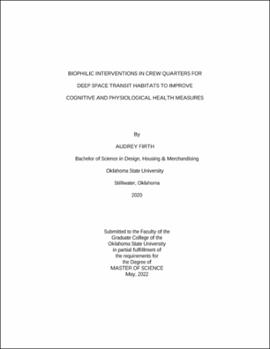| dc.contributor.advisor | Jayadas, Aditya | |
| dc.contributor.author | Firth, Audrey | |
| dc.date.accessioned | 2023-04-03T20:51:46Z | |
| dc.date.available | 2023-04-03T20:51:46Z | |
| dc.date.issued | 2022-05 | |
| dc.identifier.uri | https://hdl.handle.net/11244/337249 | |
| dc.description.abstract | While the concept of biophilic design has been around for many decades, new methods for studying and quantifying the effects of biophilic design in virtual reality present unique opportunities for interior designers and architects, while exploring design concepts for spacecrafts and space habitats. When a person experiences a space with biophilic design, it can result in both cognitive and physiological benefits. There is a critical need to not only integrate biophilia into the design of the interiors of spacecraft but to study the benefits of this as well. The purpose of this study was to assess if the integration of biophilic design in a virtual simulation of personal crew quarters on the International Space Station (ISS) can help improve emotions and feelings while also improving cognitive responses in individuals. The specific aims of the study include the following: a) Determine if virtual biophilic crew quarters result in an improvement to overall feelings and emotions when compared to the current design; b) Determine if virtual crew quarters designed with the integration of biophilic design result in an improvement in cognitive load when compared to the current design; c) Determine if virtual crew quarters designed with the integration of biophilic design result in an improvement in satisfaction and intent to spend more time in the space when compared to the current design; d) Determine if virtual crew quarters designed with the integration of biophilic design result in an improvement in cognitive responses when compared to the current design. The participants answered survey questions to assess specific measures related to feelings and emotions, task load, and cognitive responses and heart rate and pupil dilation were also measured. The study found that there were significant differences in feelings and emotions, pupil dilation, performance, and effort, and moderate to strong correlations between satisfaction with the space and intention to spend more time in the space. This study has important implications for the design of space habitats to help improve the health and wellbeing of astronauts and space travelers. | |
| dc.format | application/pdf | |
| dc.language | en_US | |
| dc.rights | Copyright is held by the author who has granted the Oklahoma State University Library the non-exclusive right to share this material in its institutional repository. Contact Digital Library Services at lib-dls@okstate.edu or 405-744-9161 for the permission policy on the use, reproduction or distribution of this material. | |
| dc.title | Biophilic interventions in crew quarters for deep space transit habitats to improve cognitive and physiological health measures | |
| dc.contributor.committeeMember | Thaxton, Sherry | |
| dc.contributor.committeeMember | Chandrasekera, Tilanka | |
| dc.contributor.committeeMember | Carter, Heather | |
| osu.filename | Firth_okstate_0664M_17714.pdf | |
| osu.accesstype | Open Access | |
| dc.type.genre | Thesis | |
| dc.type.material | Text | |
| dc.subject.keywords | biophilia | |
| dc.subject.keywords | biophilic design | |
| dc.subject.keywords | crew quarters | |
| dc.subject.keywords | interior design | |
| dc.subject.keywords | space architecture | |
| dc.subject.keywords | transit habitat | |
| thesis.degree.discipline | Design, Housing, and Merchandising | |
| thesis.degree.grantor | Oklahoma State University | |
